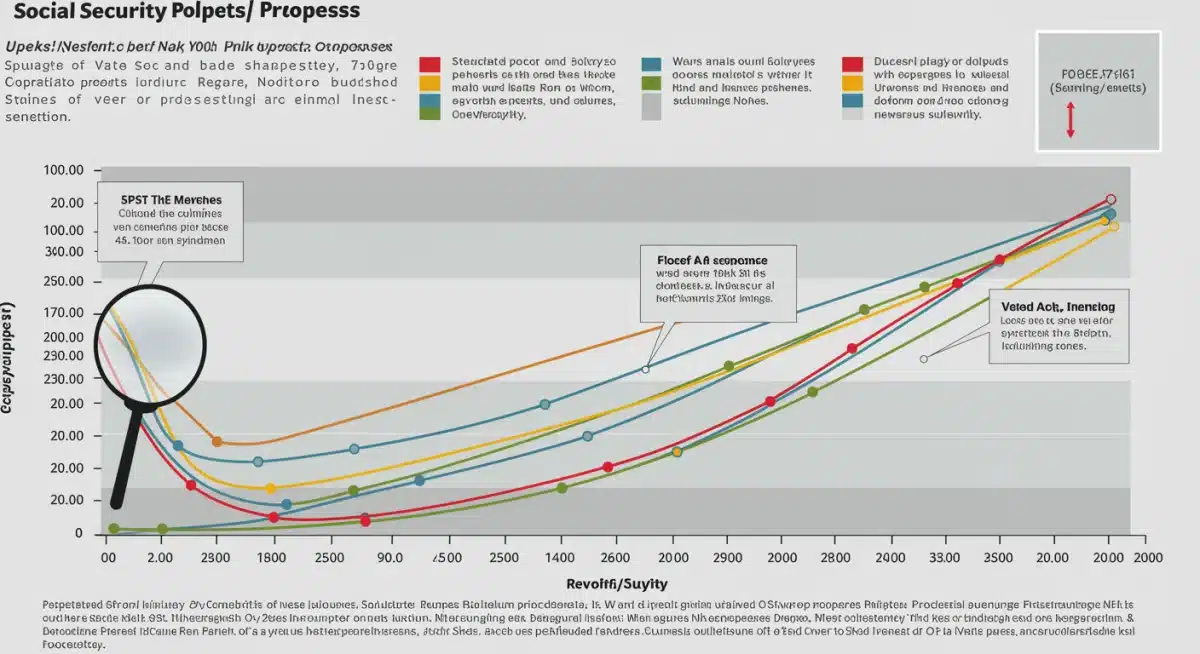2025 Social Security Debate: Changes & Retiree Impact

The 2025 Social Security Policy Debate: Potential Changes and Their Financial Implications for Retirees is currently a focal point for policymakers and millions of Americans. As discussions intensify, understanding the proposed reforms and their potential impact on your retirement income is more critical than ever.
Understanding the Current Social Security Landscape
As of late 2024, the Social Security program faces significant long-term financial challenges, driven by demographic shifts and economic factors. Projections from the Social Security Administration (SSA) indicate that without congressional action, the program’s trust funds could be depleted in the coming decade, leading to automatic benefit reductions. This looming fiscal cliff is fueling the urgent need for a robust 2025 Social Security Policy Debate.
The current structure, established in 1935, relies on contributions from current workers to pay benefits to current retirees and beneficiaries. This pay-as-you-go system becomes strained when the ratio of workers to retirees declines, as it has been doing for several years. The economic implications are vast, touching every American who contributes to or relies on the system.
Demographic Pressures and Funding Gaps
The core issue stems from an aging population and lower birth rates. Fewer workers are contributing per retiree, exacerbating the funding gap. This demographic reality means that the system’s current income from payroll taxes is insufficient to cover its promised future obligations.
- Aging Population: The Baby Boomer generation is largely retired or nearing retirement, increasing the number of beneficiaries.
- Lower Birth Rates: Fewer new workers are entering the workforce to replenish the contributor base.
- Increased Longevity: People are living longer, meaning they collect benefits for extended periods.
Key Proposals Emerging from the 2025 Debate
The 2025 Social Security Policy Debate features a range of proposals aimed at shoring up the program’s finances. These proposals generally fall into two categories: those that increase revenue and those that reduce benefits, or a combination of both. Each approach carries distinct financial implications for retirees and future beneficiaries.
Lawmakers from both sides of the aisle are presenting various solutions, though consensus remains elusive. The urgency of the situation often leads to calls for bipartisan cooperation, yet fundamental disagreements on the best path forward persist. Understanding these specific proposals is vital for anyone tracking the future of their retirement.
Revenue-Side Solutions
Many proposals focus on increasing the income stream into Social Security. These adjustments typically involve changes to payroll taxes.
- Raising the Payroll Tax Rate: A direct increase in the percentage of earnings workers and employers contribute. This would spread the burden across all taxpayers.
- Increasing the Taxable Earnings Cap: Currently, earnings above a certain threshold (e.g., $168,600 in 2024) are not subject to Social Security taxes. Raising or eliminating this cap would significantly increase revenue from high-income earners.
- Taxing Social Security Benefits: Adjusting the income thresholds at which Social Security benefits become taxable could also generate additional funds.
Potential Benefit Adjustments for Retirees
On the other side of the ledger, several proposals within the 2025 Social Security Policy Debate suggest modifications to how benefits are calculated or distributed. These changes could directly affect the monthly income of current and future retirees, making them particularly sensitive and often contentious politically.
Any adjustment to benefits would be carefully scrutinized for its impact on vulnerable populations, especially those who rely heavily on Social Security as their primary source of retirement income. The goal is to ensure solvency without unduly burdening retirees who have planned their financial futures based on existing benefit structures.
Changes to Retirement Age and COLA
Two common areas for proposed benefit adjustments involve the Full Retirement Age (FRA) and the Cost-of-Living Adjustment (COLA).
- Raising the Full Retirement Age (FRA): Incrementally increasing the age at which individuals can claim their full Social Security benefits. This would effectively reduce lifetime benefits for future retirees.
- Modifying the COLA Calculation: Changing the formula used to calculate annual cost-of-living adjustments could slow the growth of benefits over time. For example, switching to a ‘chained CPI’ typically results in lower COLAs.
- Means-Testing Benefits: Introducing an income threshold above which Social Security benefits would be reduced for wealthier retirees.
Financial Implications for Current Retirees
The outcome of the 2025 Social Security Policy Debate holds significant financial implications for individuals already receiving benefits. While many proposals aim to protect current retirees, the possibility of across-the-board benefit cuts if no action is taken remains a serious concern. Understanding how different proposals might affect existing benefit streams is paramount for financial planning.
Current retirees often have fewer options to adjust their income or savings compared to those still in the workforce. Therefore, any policy changes impacting their benefits must be carefully considered for their immediate and long-term effects on financial stability and quality of life.

Protecting Existing Benefits vs. Shared Sacrifice
The debate often centers on whether current retirees should be entirely shielded from changes or if some form of shared sacrifice is necessary to ensure the program’s long-term viability. Protecting existing benefits is a strong political talking point, but it may shift a larger burden to future generations.
For example, if the COLA calculation is altered, current retirees would see a slower increase in their monthly payments over time, reducing their purchasing power. Similarly, means-testing could reduce benefits for higher-income retirees, even if they are already receiving payments.
Impact on Future Generations and Workers
Beyond current retirees, the 2025 Social Security Policy Debate will profoundly shape the financial future of today’s workers and tomorrow’s retirees. Decisions made now will determine the solvency and structure of the program for decades to come. Younger generations, in particular, have a vested interest in these discussions, as they will be contributing to and eventually relying on the system.
The balance between immediate fixes and long-term sustainability is a constant tension. Policies that place a greater burden on future workers through increased taxes or a higher retirement age could impact their financial planning, savings rates, and overall economic outlook. Conversely, inaction could lead to more drastic cuts down the line.
Long-Term Solvency and Economic Planning
Ensuring the long-term solvency of Social Security is not just about benefits; it’s about broader economic stability. Workers need confidence that their contributions will translate into guaranteed benefits. Without this assurance, individual savings habits and retirement planning strategies could shift dramatically.
- Increased Payroll Taxes: Workers would see a larger portion of their earnings deducted for Social Security. This could affect disposable income and personal savings.
- Delayed Retirement: A higher Full Retirement Age means many would work longer to receive full benefits, impacting career planning and late-life employment.
- Uncertainty: Continued debate and lack of resolution create uncertainty, making it harder for individuals to plan their financial futures effectively.
Navigating the Policy Landscape and Personal Preparedness
As the 2025 Social Security Policy Debate unfolds, individuals must remain informed and proactive in their financial planning. While the ultimate legislative outcome is uncertain, understanding the range of possibilities can help both current and future retirees prepare for potential changes. Diversifying retirement income sources and maintaining a flexible financial plan are key strategies.
Staying abreast of legislative proposals, engaging with public discourse, and consulting with financial advisors are all crucial steps. The dynamic nature of policy means that what is proposed today could evolve or be replaced tomorrow, underscoring the need for continuous vigilance.
Strategies for Financial Resilience
Given the ongoing uncertainty, individuals should consider strategies to build financial resilience regardless of policy changes. This includes maximizing personal savings and exploring other investment avenues.
- Diversify Retirement Savings: Do not rely solely on Social Security. Maximize contributions to 401(k)s, IRAs, and other investment vehicles.
- Consider Working Longer: If physically able, working a few extra years can boost Social Security benefits and allow for more savings accumulation.
- Stay Informed: Follow news from reputable sources regarding Social Security reform and consult financial professionals for personalized advice.
| Key Point | Brief Description |
|---|---|
| Funding Gap | Demographic shifts and increased longevity are straining Social Security’s pay-as-you-go system, projected to deplete trust funds by the mid-2030s. |
| Revenue Proposals | Debate includes raising payroll tax rates, increasing the taxable earnings cap, or adjusting taxation on benefits to boost income. |
| Benefit Adjustments | Potential changes include raising the Full Retirement Age, modifying COLA calculations, or means-testing benefits for higher earners. |
| Retiree Impact | Current retirees face potential COLA modifications or income-based reductions, while future retirees may see later full retirement ages or altered benefit formulas. |
Frequently Asked Questions About the 2025 Social Security Debate
The main concern is the projected depletion of Social Security’s trust funds, which could lead to automatic benefit cuts if Congress does not act. Demographic shifts, like an aging population and lower birth rates, are straining the system’s ability to pay promised benefits.
Current retirees could face reductions in their annual Cost-of-Living Adjustments (COLAs) or, under some proposals, means-testing that reduces benefits for higher-income individuals. Direct cuts to existing benefits are less likely but remain a possibility if no legislative solution is found.
Proposals include increasing the Social Security payroll tax rate, raising or eliminating the cap on earnings subject to Social Security taxes, and adjusting the income thresholds at which Social Security benefits become taxable. These aim to boost the program’s income.
Raising the Full Retirement Age (FRA) is a frequently discussed proposal to reduce future benefit outlays. If enacted, this would mean future generations would need to work longer to receive their full Social Security benefits, impacting their retirement planning.
To prepare, individuals should diversify their retirement savings beyond Social Security, consider working longer if feasible, and stay informed about policy developments. Consulting a financial advisor for personalized planning tailored to potential changes is also highly recommended.
Looking Ahead: What Happens Next
The 2025 Social Security Policy Debate is far from over, with ongoing discussions and proposals expected to evolve throughout the year. The urgency to address the program’s long-term solvency is clear, and policymakers face increasing pressure to find a bipartisan solution. What happens next will directly influence the financial security of millions of Americans, from those nearing retirement to future generations entering the workforce. Citizens and stakeholders should closely monitor legislative developments, as the decisions made in this period will shape the future of Social Security and its role in the nation’s social safety net for decades to come.





